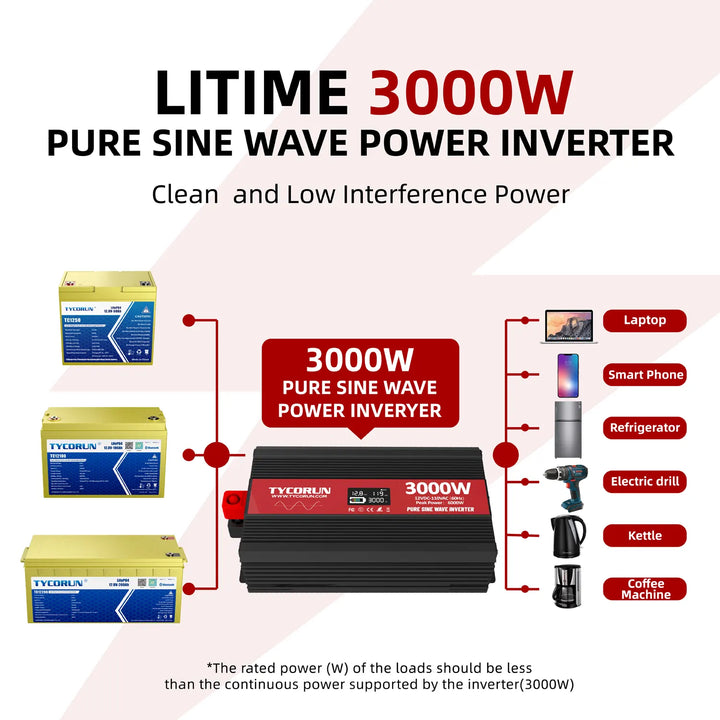
In the off grid photovoltaic system, the main function of the off grid inverter is to reverse the direct current of the battery into alternating current.
Main content:
Inverters are commonly used in off grid systems, where the input is connected to the photovoltaic controller and battery, and the output is loaded. Off grid systems are widely used, and inverters come in various forms.
1. Common operating modes of off grid inverter
In an off grid system with mains power, the inverter has three modes of operation. The application scenarios and needs of off grid photovoltaic users vary greatly, so different modes should be set according to the actual needs of users to maximize photovoltaic and meet customer requirements as much as possible.
① PV priority mode
How it works: PV preferentially supplies power to the load. When the photovoltaic power is less than the load power, the energy storage battery and the photovoltaic power supply together to the load. When there is no PV or the battery is low, if the utility power is detected, the inverter will automatically switch to the mains.
Applicable scenarios: It is used in areas where there is no electricity or lack of electricity, where the price of mains electricity is not high and there are frequent power outages. The disadvantage is that it will cause a certain amount of wasted electricity. The advantage is that if the mains power is cut off and there is still power in the battery, it can continue to carry the load. This mode can be selected by users with high power requirements.
② Grid-first mode
How it works: Whether it is photovoltaic or battery power, as long as the utility power is detected, the utility power will supply power to the load. Only after a utility fault is detected can the PV and battery be switched on to power the load.
Applicable scenarios: It is used in places where the mains power supply voltage is stable, the price is cheap, but the power supply time is short. Photovoltaic energy storage is equivalent to a backup UPS power supply. The advantage of this model is that photovoltaic modules can be configured relatively little, the initial investment is low, and the disadvantage is that photovoltaic energy is wasted, which may not be used in many cases.
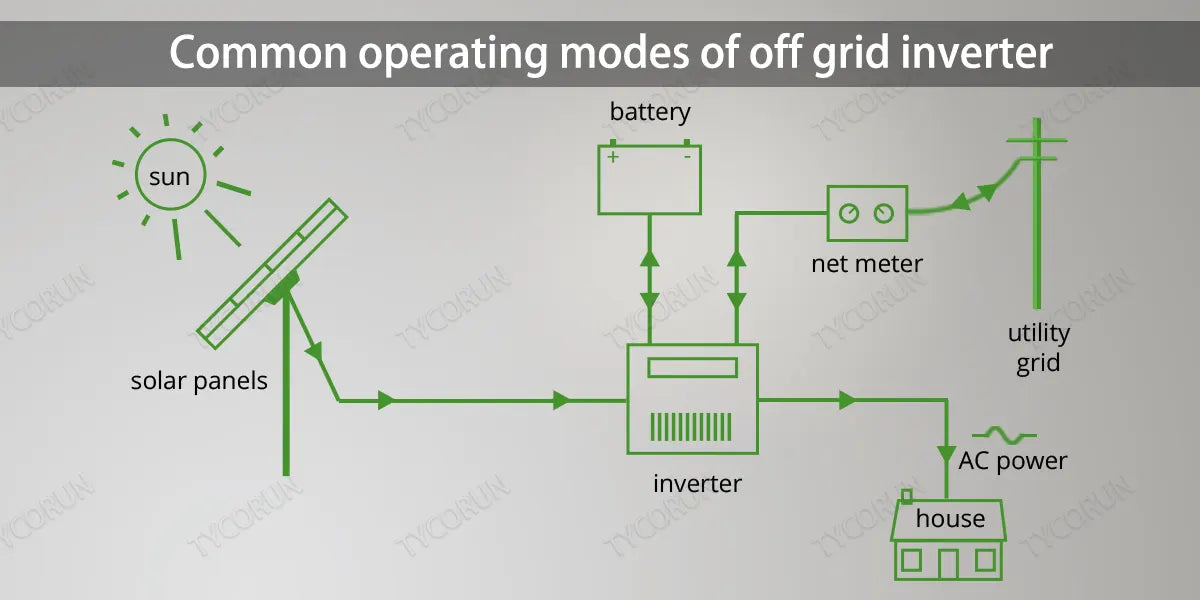
③ Battery priority mode
How it works: PV preferentially supplies power to the load. When the photovoltaic power is less than the load power, the energy storage battery and the photovoltaic power supply together to the load. When there is no photovoltaics, the battery power supplies the load separately. When the battery is low, if the mains power is detected, the inverter will automatically switch to the mains.
Applicable scenarios: It is used in areas without electricity or areas lacking electricity, with high utility electricity prices and frequent power outages. It should be noted that only when the battery power is at a low value, the inverter will switch to mains power with the load.
The advantage is that the photovoltaic utilization rate is very high, and the disadvantage is that the user's electricity consumption cannot be completely guaranteed. When the battery runs out but the mains power is cut off, there is no available power. This mode can be selected by users who do not have particularly high power requirements.
The above three modes of operation can be selected under photovoltaic and commercial power conditions. The first and third modes require the detection and switching of the battery voltage, which is related to the type of battery (usually lithium battery) and the number of installations. If there is no mains complementarity, the inverter has only one mode of operation - battery priority mode.
2. Classification of off grid inverter
① Correction wave and sine wave
The waveforms of off grid inverters are mainly divided into two categories, one is a sine wave inverter and the other is a modified wave inverter. Modified sine wave inverter, PWM pulse width modulation method to generate modified wave output, due to the presence of about 20% harmonic distortion,
It can not bring inductive loads such as air conditioning, but can carry resistive loads such as electric lights. The modified sine wave inverter adopts a non-isolated coupling circuit, which is simple and has high efficiency.
Pure sine wave inverter adopts an isolated coupling circuit design, the circuit is more complex, the cost is high, and can be connected to any common electrical equipment (including TVs, LCD displays, etc., especially inductive loads such as refrigerators) without interference.

② High frequency and power frequency inverters
Off grid inverter is divided into high-frequency machines and power frequency machines according to isolation, and there is a 50Hz power frequency isolation transformer behind the inverter, called power frequency inverter. The advantages of power frequency inverters are stable and reliable power components, high overload capacity and impact resistance, and the disadvantages are low efficiency, relatively heavy weight and high price.
Using high frequency switching technology, the power frequency transformer in the inverter is replaced by high frequency switching elements or high frequency isolation transformers, which are called high frequency inverters. There are two types of high frequency inverters: high frequency isolation and non-isolation. The advantages are small size, high efficiency, low price, and the disadvantage is that the impact resistance is slightly lower.
If the load is a large impact, it is an inductive load such as a motor, but does not move often, it is recommended to choose a power frequency inverter. If the load is a resistive load with less impact, to move frequently, it is recommended to choose a high frequency inverter. The output power of the inverter should be greater than the load power.
③ Split and one-piece
Since the off grid system has an additional battery, it is necessary to configure a controller for the components to charge the battery. The controller and off grid inverter are separated and made into two devices, which is the split type.
Split systems, controllers and inverters can be selected separately, but the wiring is more complex, suitable for systems with large power differences between components and inverters, and systems with large system power.
The integration of the controller and the off grid inverter is an integrated type, also known as the integrated control inverter type. The integrated inverter control system has a simple structure and convenient user wiring, which is suitable for systems with relatively small power differences between components and inverters.
3. How to simply determine the load type
In off grid photovoltaic systems, like distributed pv system, the power of the off grid inverter is generally confirmed according to the user's load type and power. Loads are classified according to impedance properties: resistive loads, inductive loads, and capacitive loads.
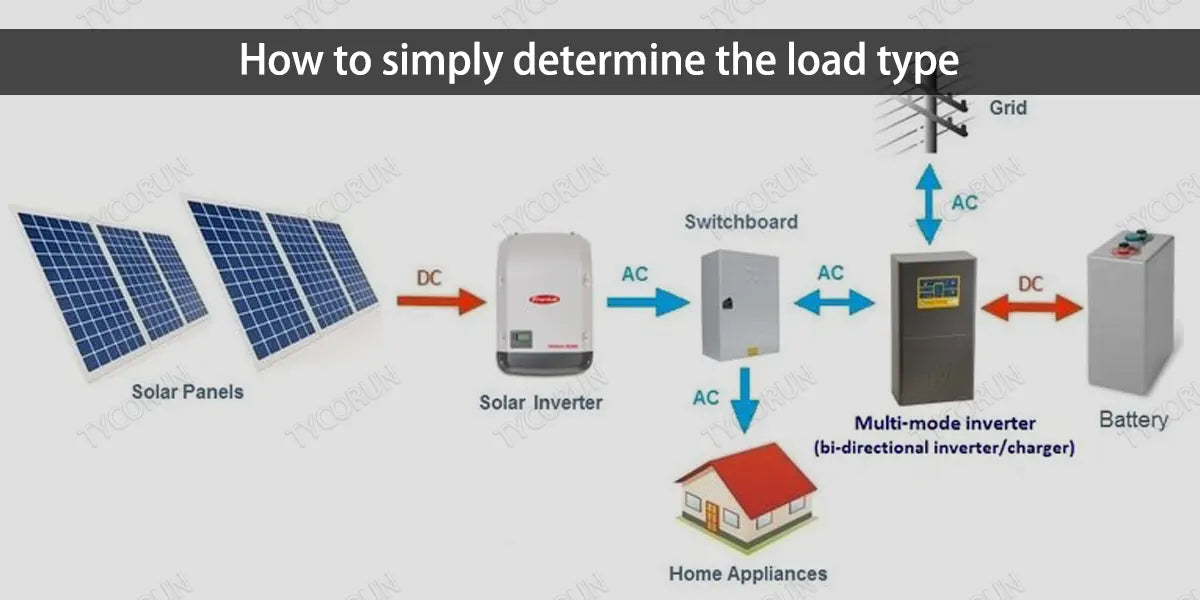
● Resistive load
Loads with no phase difference between current and voltage are resistive loads, such as rice cookers, light bulbs, electric stoves, electric soldering irons, etc.
● Inductive load
The load when the current hysteresis voltage is a phase difference is an inductive load, such as washing machines, air conditioners, refrigerators, water pumps, range hoods and other loads with motors and transformers, relays, compressors, etc.
● Capacitive load
A load with a negative phase difference in the current lead voltage is a capacitive load, such as a switching power supply used in the home, such as compensation capacitors, computers, TVs, etc. The starting power of inductive loads such as motors is 5-7 times the rated power, and the starting power of these loads should be taken into account when calculating the power of the inverter.
If the load is an elevator or the like, it cannot be directly connected to the inverter output. Because when the elevator comes down, the motor reverses, which will generate a rear EMF, which will damage the inverter when it enters the off grid inverter. If you must use an off grid system, it is recommended to add a frequency converter between the inverter and the elevator motor.
4. How to choose an off grid inverter
When choosing an off grid inverter, in addition to paying attention to the output waveform of the inverter and the isolation type, there are several technical parameters that are also very important, such as system voltage, output power, peak power, conversion efficiency, switching time, etc., and the selection of these parameters has a greater impact on the power demand of the load.
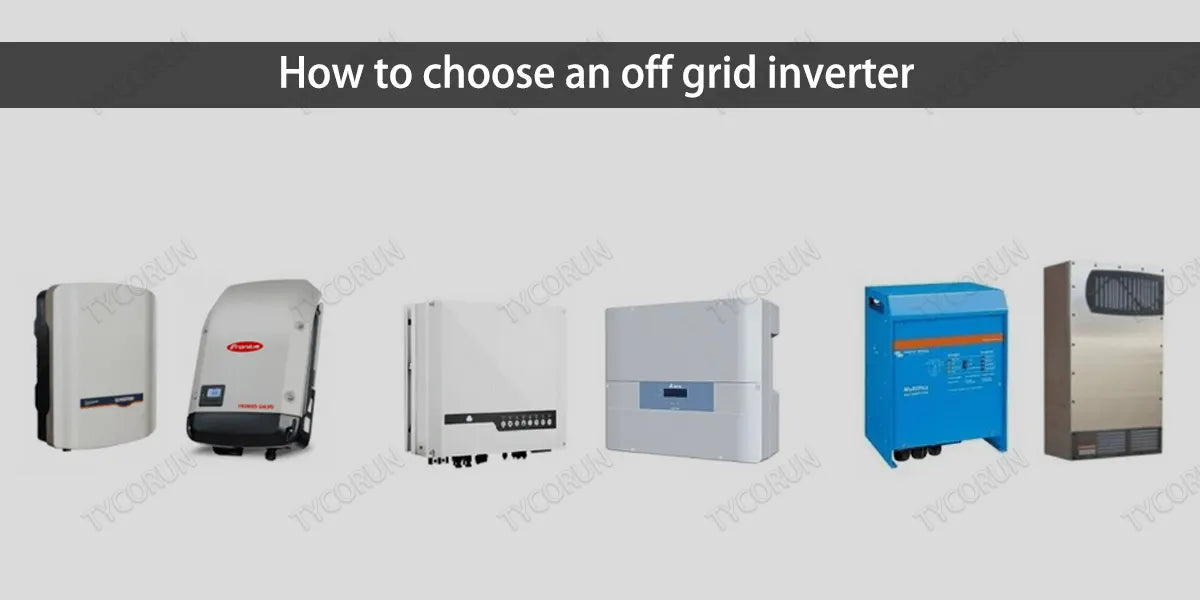
● System voltage
The voltage of the battery pack, the input voltage of the off grid inverter and the output voltage of the controller are consistent. When designing and selecting, pay attention to the consistency of the controller.
● Output power
There are two expressions of the output power of the off grid inverter, one is the apparent power representation, the unit is VA, which is a reference UPS mark, and the actual active output power needs to be multiplied by the power factor.
For example, 500VA off grid inverter, the power factor is 0.8, the actual output active power is 400W, that is, it can drive 400W resistive load, such as electric lights, induction cookers, etc. The second is active power representation. The unit is W, such as 3000W inverter. The actual output active power is 3000W.
Clike the picture to know more about TYCORUN 3000w Inverter Pure Sine Wave
● Peak power
The output power of the off grid inverter is determined by the load, and some inductive loads start the power 3-5 times the rated power, so the off grid inverter has special requirements for overload. The peak power is the overload capacity of the off grid inverter.
● Conversion efficiency
The conversion efficiency of off grid systems includes two aspects. One is the efficiency of the machine itself. The off grid inverter circuit is complex, to go through multi-stage conversion, so the overall efficiency is slightly lower than the grid-connected inverter, generally between 80-90%.
The greater the power of the inverter, the higher the efficiency, the higher the efficiency of high-frequency isolation than the power frequency, and the higher the system voltage, the higher the efficiency.
The second is the efficiency of battery charging and discharging. This is the type of battery that is related. When photovoltaic power generation system generate electricity and load electricity synchronization, photovoltaic can directly supply the load for use, and do not need to go through battery conversion.
● Switching time
Off grid system with load, there are photovoltaic, battery, mains three modes, when the battery energy is insufficient, switch to mains mode, there is switching time, some off grid inverters use electronic switch switching, the time within 10 milliseconds, desktop computers will not shut down, lights will not flash. Some off grid inverters use relay switching, which can take more than 20 milliseconds, and the desktop computer may be shut down or restarted.
5. The difference between grid connected inverter and off grid inverter
The main function of photovoltaic inverter is to convert the direct current emitted by the solar panel into alternating current used by home appliances, and the electricity emitted by the solar panel must be processed by the inverter to be output, and the use of photovoltaic inverter can be divided into grid-connected inverter and off grid inverter, so what is the difference between these two inverters?
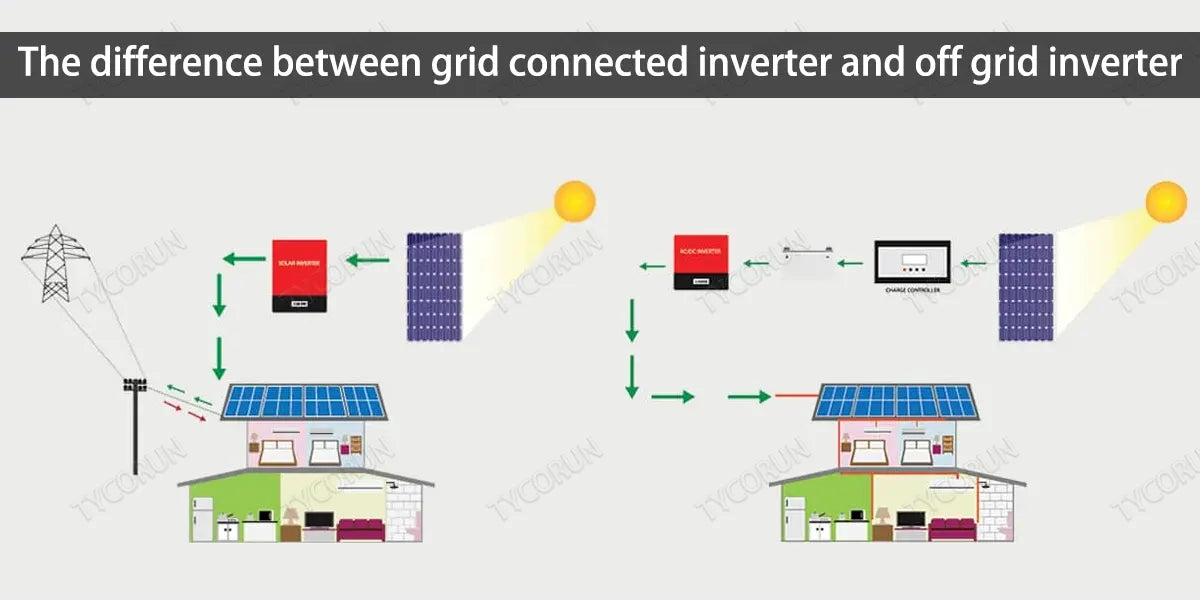
● Grid-tied inverter
Grid-connected inverters are generally divided into photovoltaic grid-connected inverters, wind power grid-connected inverters, power equipment grid-connected inverters and other grid-connected inverters for power generation equipment
And the biggest feature of grid-connected inverters is that the power of the system is high and the cost is low. Grid-connected inverters are generally used in the system of large-scale photovoltaic power stations.
● Off grid inverter
Off grid inverters generally use a complete system solution with modular components, consisting of a number of manageable building blocks: inverter, solar charge controller, automatic generator starter module, and system control board.
Off grid inverter is a system that is separated from the public grid, and the direct current emitted by the solar panel is first stored in the battery, and then transmitted by the battery to the off grid inverter . The inverter is alternating current, which can be used directly to the load or returned to the battery storage. It can be used in home energy storage system.
For remote areas that do not have grid coverage, such as deserts, plateaus, and deep forests, it is more suitable to provide power demand anytime, anywhere. The biggest difference between the two is that the grid-connected inverter does not do any battery storage.
And the direct current generated from the solar panel is directly converted into alternating current through the inverter and directly merged into the public grid, but there is also a certain threshold. That is, it must comply with the relevant regulations and policies of the local power grid, otherwise it cannot be connected to the grid.
6. Conclusion
Through the above introduction, I believe that you can choose the mode of operation of the off grid inverter according to the most suitable situation. If you want to know more, you can contact us for more professional guidance.
Related articles: Top 5 home energy storage companies, Top 10 inverter battery best companies in the world, off grid solar batteries



